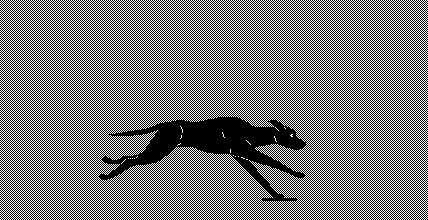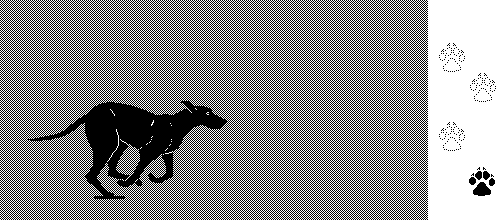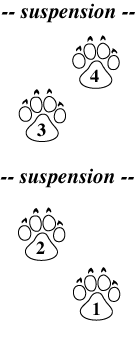A
rotatory gallop (right lead) is shown in the above cartoon. The step sequence of the rotatory gallop is shown at the right. The rotatory gallop (double suspension gallop; jumping gallop) is a four-beat, double suspension gait. It is exhibited by carnivores and by rodents, swine, and small ungulates. The pattern of limb impact rotates, e.g., right hind, left hind, extended suspension, left fore, right fore, and collected suspension (as illustrated above). This rotatory pattern of limb impact and the double suspension per stride characterizes the rotatory gallop, in contrast to the
transverse gallop.
Suspension periods follow lifting of the second-impacting hind limb and lifting of the second-impacting forelimb. As usual, the
leading forelimb is the one that is lifted just before suspension (it is the
right forelimb in the above illustration). By the same criterion, one can also designate a leading hind limb, which is the dominant propulsive limb for the gait (the left hind limb in the above cartoon).
The
rotatory gallop is the fastest but also the most fatiguing of all gaits. The greyhound can achieve speeds of 60 km/hour (37 mph). The cheetah is even faster, though it usually runs for only 15 seconds at a time. Relative to their heights, the length of the cheetah's stride is about twice that of the horse. The three-pronged antelope uses the rotatory gallop most proficiently. It has been clocked at 60 mph and can cruise at 45 mph.
In
carnivores, limbs are used for manipulation as well as for locomotion. Carnivore limbs are relatively short compared to many of the herbivores they prey upon. A carnivore gains stride length (and thus speed) by means of a flexible trunk. Flexion and extension of the vertebral column greatly increases effective stride length (compensating for anatomically short limbs).
Trunk flexion (via abdominal muscles) enables the hind paws to impact far ahead of the spot where fore paws impacted the ground. Trunk extension during hindlimb propulsion produces a leap that enables the forelimbs to impact far ahead of their static anatomical reach. Epaxial and hamstring muscles support body weight and elevate the body's center of gravity during the leap suspension phase. Abdominal wall muscles bring the pelvis forward during trunk flexion. Thus trunk muscles are significantly involved in locomotion.





